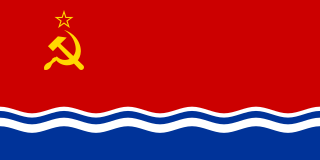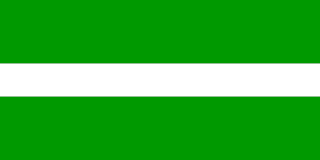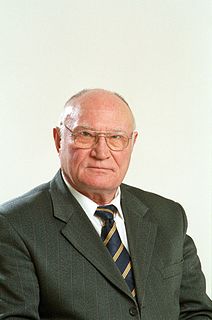
The politics of Latvia takes place in a framework of a parliamentary representative democratic republic, whereby the Prime Minister is the head of government, and of a multi-party system. The President holds a primarily ceremonial role as Head of State. Executive power is exercised by the government. Legislative power is vested in both the government and parliament, the Saeima. The Judiciary is independent of the executive and the legislature. The Economist Intelligence Unit rated Latvia a "flawed democracy" in 2019.

The Latvian Soviet Socialist Republic, also known as Soviet Latvia or Latvia, was a de facto republic of the Soviet Union.

Latvian Way was a conservative-liberal political party in Latvia. It merged with Latvia's First Party to form the Latvia's First Party/Latvian Way (LPP/LC) in 2007.

The prime minister of Latvia is the most powerful member of the Government of Latvia, and presides over the Latvian Cabinet of Ministers. The prime minister is nominated by the president of Latvia, but must be able to obtain the support of a majority of the Saeima (parliament).

The Latvian Green Party is a green political party in Latvia.

The Popular Front of Latvia was a political organisation in Latvia in the late 1980s and early 1990s which led Latvia to its independence from the Soviet Union. It was similar to the Popular Front of Estonia and the Sąjūdis movement in Lithuania.
The modern Latvian independence movement was the resistance movement to foreign occupation of the Republic of Latvia during Soviet and Nazi German occupation (1940–1991).

Aigars Kalvītis is a Latvian businessman and a former politician who was the Prime Minister of Latvia from 2004 to 2007. Currently he is the president of Latvian Ice Hockey Federation and the Chairman of the Board of Latvian gas company Latvijas Gāze. He is the Chairman of the Council of Latvian telecommunications company Tet.

Valdis Dombrovskis is a Latvian politician serving as Executive Vice President of the European Commission for An Economy that Works for People since 2019 and European Commissioner for Trade since 2020. He previously served as European Commissioner for Financial Stability, Financial Services and Capital Markets Union from 2016 to 2020 and Prime Minister of Latvia from 2009 to 2014.

Ivars Godmanis is a Latvian politician who served as the Prime Minister of Latvia from 1990 to 1993 and again from 2007 to 2009. He was the first Prime Minister of Latvia after the country restored its independence from the Soviet Union.

The Constitution of Latvia is the fundamental law of the Republic of Latvia. Satversme is the oldest Eastern or Central European constitution still in force and the sixth oldest still-functioning republican basic law in the world. It was adopted, as it states itself in the text, by the people of Latvia, in their freely elected Constitutional Assembly of Latvia on 15 February 1922 and came into force on 7 November 1922. It was heavily influenced by Germany's Weimar Constitution and the Swiss Federal Constitution. The constitution establishes the main bodies of government ; it consists of 115 articles arranged in eight chapters.

Vilnis Edvīns Bresis was a Latvian politician who was the Chairman of the Council of Ministers of the Latvian SSR from 6 October 1988 to 7 May 1990.

The Declaration "On the Restoration of Independence of the Republic of Latvia" was adopted on 4 May 1990, by the Supreme Soviet of the Latvian SSR. The Declaration stated that, although Latvia had de facto lost its independence in 1940, when it was annexed by the Soviet Union, the country had de jure remained a sovereign country as the annexation had been unconstitutional and against the will of the Latvian people. Therefore, it resolved that the Molotov–Ribbentrop Pact and the Soviet occupation of Latvia in 1940 were illegal. It also asserted that the heavily rigged 1940 elections were illegal and unconstitutional, and that all acts of the "People's Saeima" chosen at that election–including the request to join the Soviet Union on 21 July 1940–were ipso facto void.

The president of Latvia is head of state and commander-in-chief of the National Armed Forces of the Republic of Latvia.

Belarus–Latvia relations are the foreign relations between Belarus and Latvia. Currently, Belarus has an embassy in Riga, while Latvia has an embassy in Minsk. The countries share 161 km as it relates to their common border. In May 2021 the relations were de facto terminated as both countries were expelling each other's diplomats of the corresponding embassy, Latvia was insisting to use an inaccurate opposition flag as a representation for Belarus in the Ice Hockey World Championship in Riga over the Ryanair Flight 4978 diplomatic row. Belarusian Foreign Minister Vladimir Makei called Latvias move 'an act of international vandalism' and called for an apology and return the legal green, red and white flag to its original place. The Belarusian government reacted with expelling every Latvian diplomat including the Ambassador inside the country, with Latvia following with the same response. The Zurich-based International Ice Hockey Federation sided with Belarus and asked the mayor of Riga to urgently take down the IIHF flags to protest to what the body called a political gesture.
The Sovietization of the Baltic states refers to the sovietization of all spheres of life in Estonia, Latvia and Lithuania when they were under control of the Soviet Union. The first period deals with the occupation from June 1940 to July 1941 when the German occupation began. The second period covers 1944 when the Soviet forces pushed the German out, until 1991 when independence was declared.

The first Dombrovskis cabinet was the government of Latvia from 12 March 2009 to 3 November 2010. It was the first government to be led by Valdis Dombrovskis, who was Prime Minister from 2009 until 2014. It took office on 12 March 2009, after the resignation of Ivars Godmanis, succeeding the second Godmanis cabinet, which had lasted from 2007 to 2009. It was replaced by the second Dombrovskis cabinet on 3 November 2010, after the October 2010 election.

The second Godmanis cabinet was the government of Latvia from 20 December 2007 to 12 March 2009. It was the second government to be led by Ivars Godmanis, who was also Prime Minister from 1990 to 1993. It took office on 20 December 2007, after the resignation of Ivars Godmanis, succeeding the second Kalvītis cabinet, which had lasted from 2007 to 2009. It was replaced by the second Dombrovskis cabinet on 3 November 2010, after the October 2010 election.

The second Kalvītis cabinet was the government of Latvia from 7 November 2006 to 20 December 2007. It was the second government to be led by Aigars Kalvītis, who had previously been Prime Minister since 2004. It took office on 7 November 2006, after the October 2006 election, succeeding the first Kalvītis cabinet, which had lasted from 2004 to 2006. It was replaced by the second Godmanis cabinet on 20 December 2007, after the resignation of Kalvītis.

The dissolution of the Soviet Union (1988–1991) was the process of internal political, economical and ethnical disintegration within the USSR as an untoward result of General Secretary Mikhail Gorbachev's effort of political and economic reform of the Soviet authoritarian system and declining planned economy, which resulted in the end of its existence as a sovereign state. After a 1991 military coup attempt in Moscow led to a complete disintegration of the country, Gorbachev had to first retire as leader of the Communist Party since it practically ceased to work, then to resign his office as president and what was left of the parliament to formally acknowledge the Union's collapse as a fait accompli.















